Jamology Jam, Cheese & wine Pairings

"Oncques Deus ne fist tel mariage comme de poire et de fromage"
"God has never made a marriage as successful as that between the pear and the cheese." France, year 200
The pairing of cheese with fruit is heavenly but in order to reach heaven, there is a
formula to follow: some fruit jams combine with some cheeses better than others.
The happy marriage of cheese and jam is a chemical one: cheeses are practically
sugar free and jams therefore complement them perfectly, creating a balance for the
palate.
The world of cheese and jam pairings on a cheese tray or cheese board offers a
wide range of taste and texture options. So much so that it could be quite
overwhelming without a guide.
There are four key principles to bear in mind:
• Combine the flavors on your cheese-jam plate by including other items that offer
complementary flavors. You want a balance of the sweet, the tart, the salty and the
acidic (and maybe some spice). The jams are sweet, the cheese tends to be mild
and fatty, so consider olives, salty cured meats, or acidic fruits like apples or citrus.
• Consider contrasting textures (e.g. crunchy crackers or nuts with creamy cheese
and whole-fruit jams rather than jellies).
• The visual display is important. A wood or slate cheese board becomes a true thing
of beauty when you arrange it with pale yellow cheeses, jewel-toned jams, and fresh
crisp micro-greens.
• And finally, think about convenience, especially during busy holidays. Some
condiments come in jars that are attractive enough to plop right on your cheese
board next to its intended cheese partner.
The great thing about cheese plates is people with different tastes and/or diets can
pick and choose whatever suits them.

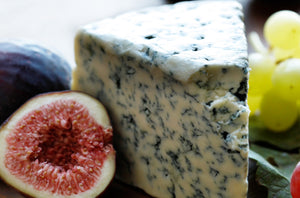
Cheese Plates
The great thing about cheese plates is people with different tastes and/or diets can pick and choose what suits them.
The great thing about cheese plates is people with different tastes and/or diets can pick and choose what suits them.
Ingredients
Buying the Cheese
A basic cheese plate should include at least three types of cheese: cow, sheep, and
goat, with a variety of hard, soft and blue types. Flavor and texture juxtaposition is
important. As a general guideline, assume each person will eat at least 2 ounces of
each cheese.
Here are some ideas that can add variety in taste, texture and convenience.
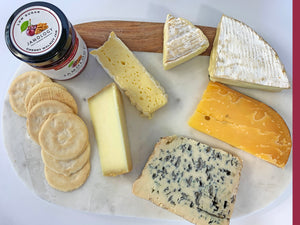
Jamology Cherry walnut cheese pairing
Triple cream
Epoisses
Camembert
Brie
Goat cheeses
Gouda
Ossau Iraty
Gruyere
Blue
Wine pairings
Michael from D&M wine and liquor store on Fillmore street in San Francisco was the
inspiration for this pairing: "This is a jam that does what it says on the tin - the cherry
and walnut flavors are precisely defined and not overly sweet. As such wines that
are aged for extended periods of time in American oak will work well - the vanilla and
deep fruit notes of the wine pair with the similar character in the jam. By the same
token, oxidized wines from Jerez or Jura will work well, with Oloroso Sherry perhaps
being number one. Oxidized and oaked Champagnes based on the Pinot Noir grape
are also worth considering here."
Recommendation:
Napa Cabernet
Australian Shiraz
Traditional Rioja-- Riserva or Gran Riserva
Oloroso Sherry
Jura France's Vin JauneOlder
Oxidative Style Champagne: Houses like Bollinger or Pol Roger, Growers like Selosse or R. Renaudin
Jamology Fig cheese pairing
Brie
Triple cream
Blue
Goat' cheese
Manchego
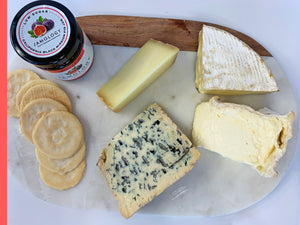
Wine pairings
In helping to do this pairing Michael from D&M Wine and Liquor said: "This took me
a bit longer to think through, and I leaned on the work of Francois Chartier (author of
"Taste Buds and Molecules: The Art and Science of Food and Wine") to think of
what would work well with that wonderful earthy fig quality. Aromatic red wines with a
good amount of fruit worked out better than fuller and more present reds. The figs
actually also worked pretty well with the aromatic wine category, i.e. vermouth and
various other wine and herbal concoctions. Fino sherry ended up being a great fit as
well with its zippy, salty tone cutting nicely though the richness of the figs."
Recommendations:
Spanish Grenache
Gigondas
Cotes du Rhones (based on Grenache)
Antica Formula Vermouth
Cap Corse Rouge (Corsican aromatized wine) *aperitif
Fino Sherry
Sauternes
Sherried scotch from the Highlands (Macallan, Balvenie 12 or 17, Glenfarclas)
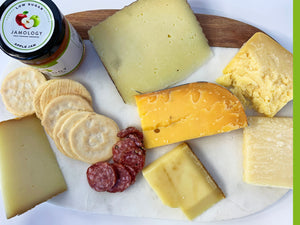
Jamology Apple cheese pairing
Cheddar
Parmigiano
Manchego
Comte
Gouda
Ossau Iraty
Gruyere
Cured meats
Wine pairings
Michael from D&M wine and liquor store on Fillmore street, San Francisco: "This was
definitely one of the easiest pairings to do as apple plays very well with other flavors,
and the baked spice tone from a Calvados won't hurt either! Here I was guided by
wines that have either a bit of that spice built in like a Burgundy / Chardonnay or that
have a little bit of aromatic lift, to balance out the hearty character of the Apple Jam.
This could also play well with the increasingly popular 'orange wine' category. This
would also work well with Normandy or English ciders - as long as they are not too
dry."
Recommendations:
Pinot Noir dominate Champagne: Bollinger, Drappier, Henri Goutorbe, Jacquesson
Sonoma County Chardonnay
Western Australia Chardonnay
Skin Contact / Orange Wine
German Wines with a little sweetness (German Rieslings with the word Spätlese)
White Chateauneuf du Pape
White Bordeaux (aged in oak)
Normandy or English Ciders

Plate Preparation
Cheese tastes best when served at room temperature. Set knives on or near the
cheese plate. Cheese markers are a fun way to identify the types of cheese you are
serving. Provide napkins and small plates.
Set the cheese out a half-hour before eating to bring it up to room temperature.
Ideally, put out a separate serving knife for each cheese or put out one knife for hard
cheeses like Gruyere and Ossau-Iraty, and then a separate knife for the Humboldt
Fog, or any cheese which is softer and messier. If you don't have a serving platter, a
regular dinner plate can work just fine. As a rule of thumb, plan for each guest to eat
1-2 ounces of each cheese you serve.
HOW TO EAT
Put a dollop of Jamology preserves on a slice of baguette or a cracker with a piece
of cheese or serve the Jamology preserves next to a cheese plate and let guests try
different fruit and cheese combinations on their own.
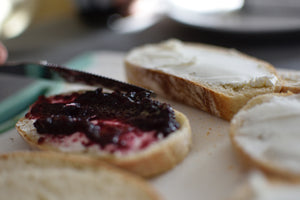
HOW TO EAT
Put a dollop of Jamology preserves on a slice of baguette or a cracker with a piece of cheese, or serve the Jamology preserves next to a cheese plate and let guests try different fruit and cheese combinations on their own.
